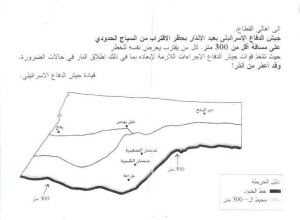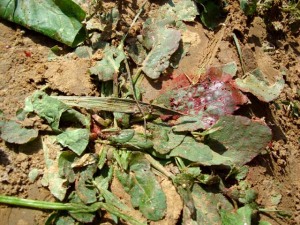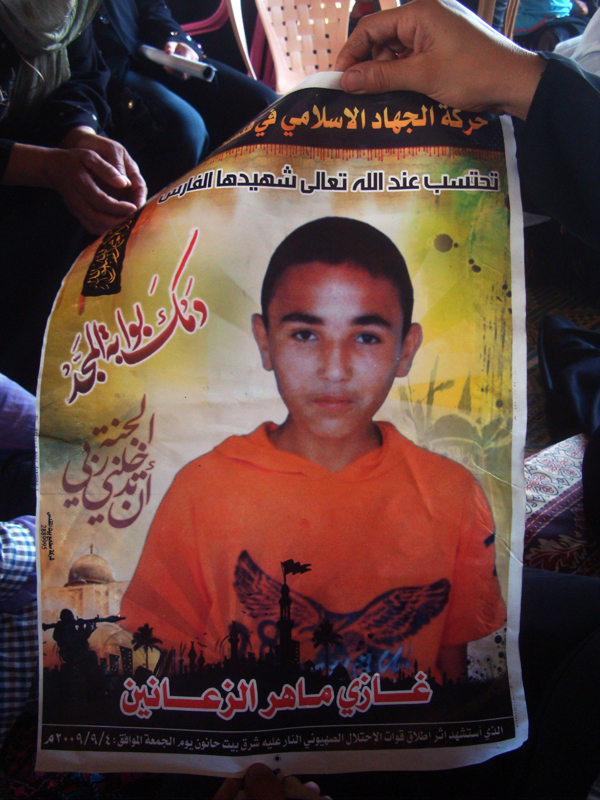

“Life is hard for Palestinian farmers in the border region near Israel. The IOF shoot at us every day, any time. They shoot at the international volunteers (ISM) also.”
This was Jaber Abu Rjila testifying some of what he has experienced in the last decade on his land less than 500m from the border with Israel.

Yesterday, the day before Abu Rjila was interviewed, Israeli occupation forces dropped leaflets along the border area, from north to south, announcing Israel’s unilateral decision that the border area is off-limits and that, by dropping leaflets, Israeli soldiers have the right to shoot to kill anyone found within 300m of the fence. [see translation of the message at the bottom of the page]
Dropping leaflets to try to legitimize Israeli crimes is nothing new: during the 23 day massacre of Gaza, Israeli soldiers dropped leaflets announcing areas which were subject to mass-bombing, saying the residents must leave. Such action does not suddenly render international law insignificant, nor –even if legality were not a question –does it realistically afford the Palestinian civilians in question any option of alternate existence.
During the war, there was no place that people in Gaza felt safe, for good reason, as Israel bombed anything moving and any sanctuary. The leaflets were irrelevant.
As they are here. The farmers and civilians living in the so-called ‘buffer zone’ (Israel-designated; running only along the Palestinian side) have no options to relocate. Gaza, as one may recall, is an incredibly small and densely-populated strip. An incredibly impoverished strip, after the manufactured economical, employment, sanitation, health, nutrition, and education crises, to name just some.
The farmers and civilians living in the 500m to 1 km region along the border have in many cases worked this land for generations. For the majority, this is their only source of income, however meager that may be, particularly since Israel does not allow the export of goods formerly sent to European markets, like strawberries, fruit, carnations, all of which fetched impressive prices.
Those farmers who do not live on the land are working it as their only source of employment, taking home at best $5 a day, when they feel like risking their lives to work.
The Israeli declaration that they will shoot anyone in the border regions is nothing new: Israeli soldiers have been targeting Palestinians and the internationals who accompany them for years. Since the end of the war on Gaza, January 18, alone Israeli soldiers have killed at least 3 people in the border region, including a child, and have injured another 12, including 3 minors and 2 women.
Many of these injuries have occurred at distances greater than 300m, greater even than 500m, from the fence. The injured and killed have been clearly unarmed, visibly no threat to well-armed Israeli soldiers.
In our days accompanying farmers, we have seen Israeli soldiers park their military jeeps and hummers, observe the farmers for lengthy periods, and suddenly begin to shoot dangerously close to the farmers and to us. The soldiers have had ample time to count the number of people present, to watch our activities (the most dangerous aspect of which may be slicing parsley or some poor attempts at Dabke dancing in quieter moments).
Some incidents, recapped, to highlight just how these Israeli army aggressions affect and destroy Palestinians lives:
-Maher Abu-Rajileh (24) from Huza’ah village, east of Khan Younis, was killed by soldiers on January 18 when he returned with his parents and brother to farmland 400m from the Green Line following Israel’s announcement of a ceasefire. At 10 am, after he had spent two hours cleaning up the land from the destruction wreaked by Israeli bulldozers and tanks, Israeli soldiers opened fire, shooting Maher in the chest, killing him instantly.
-On Jan. 20, Israeli soldiers fired on residents of Al-Qarara, near Khan Younis, shooting Waleed Al-Astal (42) in his right foot.
-Soldiers opened fire on Khuza’a village, east of Khan Yunis, on Jan. 23, shooting Nabeel Al-Najjar (40) in the left hand.
-On Jan. 25, Israeli soldiers shot Subhi Qudaih (55) in the back while he was on Khuza’a village farmland.
-On Jan. 27, just outside of Al-Farahin, also east of Khan Younis, soldiers killed Anwar Al-Buraim (26), shooting him in the neck while he picked vegetables on land approximately 500m from the Green Line.
-On February 14th, at approximately 12:00, the body of Hammad Barrak Salem Silmiya, 13, from al-Qerem area east of Jabalia town in the northern Gaza Strip, was brought to Shifa’ Hospital in Gaza City. The child had been shot in the head. According to his family, IOF troops fired at him while he was herding animals in the east of Jabalia town.
-On Feb. 18, farmers returned to harvest land approximately 500 metres from the Green Line where Anwar Al-Buraim was shot dead weeks earlier. As the farm workers were leaving the land, Israeli soldiers targeted Mohammad Al- Buraim, a deaf 20-year-old and cousin of Anwar. Mohammad was with a group of approximately ten farmers pushing their stalled pick-up truck loaded with harvested produce when Israeli soldiers began sniping, hitting Mohammed in the right ankle and continuing to shoot as the farmers, surrounded by international human rights observers, moved away from the field and took shelter behind a nearby house.
-On February 24th, after shooting at farmers and internationals accompanying them in the morning, Israeli soldiers shot a 17 year old girl in the kneecap as she stood near her demolished home roughly 800m from the border. Her knee was completely shattered.
-On March 10th, at approximately 15:30, IOF troops positioned at the border between the Gaza Strip and Israel to the east of al-Maghazi refugee camp in the central Gaza Strip fired at Palestinian houses in the camp. As a result, Muhannad Sehi Abu Mandil, 24, was wounded by a gunshot to the left foot.
-On May 5th, 35-year-old Nafith Abu T’eima sustained light injuries following several gunshot volleys from a passing Israeli militarized jeep, and was hit in the neck with shrapnel. He was tending his lands at the time of the incident and evacuated to hospital.
-On May 7th, 32-year-old Randa Shaloufeh, was working her land near the Israeli-Gaza border when soldiers fired at her. She was shot in her chest and hand.
-On April 10th, a handicapped Palestinian woman, Leila Abu Dagga, was injured when she fell down the stairs from the roof of her house while she was fleeing Israeli soldiers’ gunfire.
And regarding the damage done to land, crops, equipment, and export:
-On May 4th, Israeli troops set fire to Palestinian crops ranging along a 4km stretch along the border. The Palestinian Centre for Human Rights (PCHR) reported that 200,000 square meters of crops were destroyed, including wheat and barley ready for harvest, as well as vegetables, olive and pomegranate trees.
-Ismail Abu Taima explained that over the course of the year he invests about $54,000 in planting, watering and maintenance of the monthly crops. From that investment, if all goes well and crops are harvested throughout the year, he can bring in about $10,000/month, meaning that he can pay off the investment and support the 15 families dependent on the harvest.
Ismail Abu Taima collected valves from the broken irrigation piping. The pipes themselves had been destroyed by a pre-war on Gaza invasion. “The plants have not been watered since one week before the war,” he’d told us. He collected the parts, each valve valuable in a region whose borders are sealed and where replacement parts for everything one could need to replace are unattainable or grossly expensive.
He’d also told us of the chicks in the chicken farm who’d first been dying for want of chicken feed, and then been bulldozed when Israeli soldiers attacked the house and building they were in.
-Abu Alaa lives in Khan Younis and owns land in the newly-extended “Buffer Zone”, the strip of land along the Green Line which, from North to South, cuts into Palestinian land by a full 1 km now.
Israel’s ongoing control of Gaza and its borders has meant that those farmers able to produce vegetables, fruit or flowers cannot export them. For the last 3 years, the flower and strawberry exports have near-completely ceased.
Whereas former years saw over 40 million flowers exported for sale in European markets, Israel finally deigned to allow out a fractional 25,000, much too little, much too late. Last year farmers fed flowers to their animals, in protest and frustration at the closed borders.
-At 2:30 pm January 17, 4 massive Israeli tanks and 1 towering military bulldozer accompanied a smaller military bulldozer and invading, occupying Israeli soldiers as they blazed towards Manwa’s, yelling through a megaphone, ordering them to get out of the house. Sharifa, 22, left first. Soldiers asked her if there were any men inside the house, to which she replied ‘no’. Manwa came next, also with hands in the air. The question was repeated, soldiers not believing the women could stay by themselves, telling the women as much.
It was 3 weeks after Israel’s Gaza-wide air-strikes began, and the fact that Manwa and Sharifa had stuck it out alone in that isolated area is incredible.
“They told me our house was now in a closed military zone,” Manwas said. “They said it was a ‘decision from the top’ and that we had to leave immediately and walk towards Gaza,” she said. “I refused, and tried to negotiate with them for time to gather our belongings. They refused.”
Manwa was a safe distance away, watching, when the Israeli soldiers bulldozed her house at 5 pm that day.
This was one day before Israel declared a ceasefire…
The flat fields around us once held olive, lemon and palm trees, Saber tells us. About 750 dunums (1 dunum=1000 square metres). “People from all over Gaza had jobs here. It is one of the best regions for agriculture in Gaza,” Saber goes on. He doesn’t need to spell out that all of the trees had been bulldozed, like the houses, over the years since 2003. We know, are aware of Israel’s policy of razing Palestinian land.
-accounts of various farmers in the ‘buffer zone’
translation of the flyer:
(on both sides the same writing but different maps)
to the people of the strip:
the israeli defence forces repeat their alert forbidding
the coming close to the border fence at a distance less than 300 metres
who gets close will subject himself to danger whererby the IDF will take necessary procedures to drive him away which will
include shooting when necessary
he who has alerted shall be excused!
-the IDF

*Palestinian home roughly 500m from the border with Israel, bearing the traces of various Israeli soldiers’ shooting incidents.

*blood from Mohammed al Buraim, shot in the ankle by Israeli soldiers on February 18th.
 Gaza, May 24, (
Gaza, May 24, (







 Please wait ...
Please wait ...










